Welcome to the Zartman cruising blog

Welcome to Zartman Cruising, the blog with which we hope more fully to chronicle our family’s sailing adventures, with all the mishaps, triumphs and in-betweens that come our way. If you’ve not read our stories in Cruising World or BoatUS magazines, take a quick peek at the “About Us” page, or browse the links to magazine articles and books in the sidebar to get a picture of who we are and what we’re doing. As time goes by we hope to fill this website out with lots more resources: cruising ideas, navigation tips, child-rearing solutions, everything, in short, that’s on our minds. But these things take time, and for now our blog begins in Newport, Rhode Island, at the end of what’s proved to be a long-ish winter. Tomorrow is the first day of Spring, yet it snowed again this morning, leaving a slushy mess on all the piers at the marina, and sliding off of the shrink-wrap winter canopy with a soft “whoosh” as the day warmed up.
Our neighbors tell us that last winter wasn’t like this; that snow only fell once or twice. It would have been a perfect year for getting the boat ready for an early start. This year is not, and the list of things to do once we can remove the winter canopy is staggering. Of course there’s still plenty to do while under wraps—borrowed charts to photocopy, sort and fold; new kit to shop for; this website to set up, even—but we’ve been at that all winter and are ready for a change. With a sailing date set almost in stone, the rest of the time is just filler. But we need to fill it with action if we’re going to cast off before Memorial Day to sail to Nova Scotia. If we’re late for that, we’ll have to rush through to get to Newfoundland in time, and if we’re late for that, our window to cross the Atlantic to Ireland might catch us unprepared or unrested. So come on, Winter! We have big hopes for this year, and we need to put some action behind them if we’re going to see them accomplished.
Ganymede’s winter turns to spring
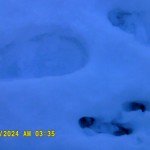
It has been the longest, coldest winter Ganymede has ever seen—rightly so, since it’s our first in these northern parts, but we’re told that it’s being cold this long is unusual even for here. There is a list, dozens of items long, of projects that must get done before we can sail for Canada and beyond this summer, but most of those things require warmer temps and to have the winter canopy removed. There’s been a gradual increase in temperature for the last few days, but nothing near enough to make us even think of dismantling the life-giving canopy, which has not only kept us warm and dry over the winter, but provides a gargantuan amount of extra storage space. We’ve grown accustomed to our elbow room inside, and quite enjoy having a coat and shoe closet outside, but at the same time we’re beginning to grow antsy, knowing that all these projects that must be done will require time, and our sailing date can’t be pushed back very far. Of course it’s not as though we don’t have plenty to do with the canopy up: there’s some painting that would benefit from being sheltered while it dried, there’s a lot of sewing Danielle’s trying to do at her machine, set up in the cockpit, and there’s our biggest winter project: getting together all the necessary charts for the upcoming cruise. In the past, we simply bought our charts from Bellingham Chart Printers in Washington, who sell very convenient folios of US-published charts, printed in black and white (or ‘Grayscale’ as they call it), and reduced to 2/3 size, which fits beautifully on our chart table. We used their charts all the way from California to Florida, and before that when we were sailing in Capella, and find them easy to use and affordable. But our future cruising plans take us to places that Bellingham doesn’t carry charts for—Canada and the UK. There’s a small selection of very outdated charts on their catalog, but they seemed reluctant to sell even those, and we decided to poke around elsewhere and see what we could find.
We hadn’t poked long before we found our very own neighbors had a goodly heap of English charts bequeathed by their vessel’s former owner, and we lost no time in borrowing those and taking them to the large-format copiers at Staples. Our editor at Cruising World magazine was kind enough to let me look through their stash of charts, which filled out the collection a little more, and better yet, netted me a good few crusing guides. Another neighbor found a heap of Nova Scotia charts, which we also borrowed and copied, and if just one more person follows through on his promise of Newfoundland charts, we’ll have all the coverage we need.
Given the cost of making color copies, and the hundreds of copies we’ve made, we did them all in black and white. Some charts, especially the older ones that were never meant to be in color, are very easy to read. The easiest are several ancient Nova Scotia harbor charts, drawn from a survey done over a hundred and fifty years ago, and having absolutely no latitude and longitude marks at the edges. So there will be no plotting GPS positions on those! But as long as the bearings are still the same, they’ll be perfect for piloting. The newer charts, which distinguish between land and sea and rocks by colors, rather than by shading, are nearly impossible to read in black and white. So one of our tasks, as winter slowly gives way to spring, is to illuminate our charts with colored pencils. Green for Ireland, a brownish-gray for England, yellow for France, and all the fathom lines in deepening shades of blue. We did this, years and years ago, to our first set of copied Caribbean charts, and found it a splendid way to get acquainted with places soon to be visited, and to put foreign-sounding names on a mental map.

Of course even with winter going so long we’re behind on that, since there’s hundreds of charts to color, and each must be meticulously done. But we’ll do the most important first, and as we cruise we can hopefully find time to color in each chart before we need it. I can only hope that by the time we’re done we’ve used them all.
Ganymede’s Non-systems
Six Simple Alternatives to Common Cruising Clutter
As we prepare Ganymede to head off on the next and biggest leg of our family cruise, these questions inevitably come up: “What new stuff do we need?” “What needs improving?” and “What can we get rid of?” Being about three and a half years and 7,500 sea miles into this journey, we’ve managed to shake everything pretty well into place, as well as to streamline our list of wants and needs into things we really need and really want. Three things that we really wished for, and had time to think about and wish for some more, were a wind-steering vane, a bigger storm sail, and a proper jib.


Though I had built a self-steering mechanism of my own, it hadn’t worked out (Maybe I’m only good for simple things), and we ended up hand-steering 99% of the way. Gets tiresome, so last summer we purchased and rebuilt a used Sailomat wind vane. We have still to try it out, but in a couple of weeks we’ll get that chance.

A jib also we had made last summer, and found in sea trials that it balanced the mainsail most gloriously, allowing Ganymede to carry the sail full into stronger winds without getting weather helm, which had been a problem before. We liked our jib so much that we also had Jasper and Bailey, the local sailmaker, measure Ganymede for a storm trysail, an extra big one for milder gales, with a deep reef for really heavy weather. Hopefully it will be delivered soon and we can see how it fits before taking off.
One of the nice things about the want/need list is its shortness, which can probably be attributed to our contentment with how things are. Ganymede is characterized less by what it has than by what it doesn’t have, and here’s a short list of things we went without that most boats have as a matter of course, but who’s absence we’ve not really minded.

1). Water tanks. While Ganymede was under construction, we collected scores of plastic gallon and half-gallon juice bottles to carry water in instead of built-in tanks. We’ve been using them now for three + years as our only water supply, and find them durable, clean-able and easy to use. Sure, it takes longer to fill them from a hose than a water tank would, but it’s far easier to fill jugs in remote areas where there is no water dock to tie the big boat up to, and not having to tote 5-gallon water jugs around and empty them into onboard tanks is a mercy. There’s also the comfort of knowing that if bad water gets into some of the jugs, you haven’t contaminated all your water supply and plumbing. Which leads to eschewed item number two:

2). Freshwater plumbing. No big tanks means no hose runs, no pumps to leak and rebuild, no sink drain that needs a through-hull and shutoff valve. Instead of a sink, we keep a plastic tub discreetly under the galley counter where all the dirty dishes go. In the tropics, the tub gets put into the cockpit for dishwashing, where we draw up sea water with a bucket. In colder places, a towel draped over the salon table makes a perfect washing station. We keep a half-dozen of the plastic tubs around, and use them for laundry as well.

3). Inboard engine. Not only could we not afford one financially, we couldn’t afford it space-wise. Where the engine would normally go there is on Ganymede a spacious cabin with seven-foot bunks, and no noise, smell or mess inside the boat (other than what the children make). But we’re not purists enough to do without a motor entirely, so we have an 8-hp, 4-stroke, long-shaft, high-thrust Yamaha outboard on a home-made bracket. Maybe it’s not a powerful as an inboard diesel, but it’s a lot cheaper and easier, and does very well as an auxiliary.

4). 12-volt electrical system. We did without one on Capella, our first sailboat, and found we didn’t miss it in the least, so we’re blissfully free of that again. Though not as bright as electric lights, our five kerosene lamps are most reliable and have a charmingly pleasant glow. Everything necessary, like a GPS, shortwave receiver, VHF and flashlights, runs on AA batteries.

5). Dodger and Bimini. We’ve been told of the impossibility of cruising in the tropics without these, but it’s really quite easy. At anchor a vast awning keeps us shadier than any bimini, and if necessary a dark-colored sheet, creatively rigged with clothespins and twine, does nicely while underway. As for a dodger, I prefer to avoid taking that kind of spray over the bows, but if we sometimes do, isn’t a little salt water part of the seafaring life?

6). Dinghy motor. Not only are they burglar bait, but if I didn’t have a little rowing to do, I’d get frightfully out of shape. The last thing I want to do, when I have to leisure to enjoy a quiet and possibly hard-won anchorage, is to go roaring about with the clatter of an outboard in my ears. There are some places where the tide will dictate your coming and going more than you’d like, but I can count on one hand, and still have fingers left over, the times I’ve really wished for a dinghy motor.
Those six items are the main ones I can think of that most other cruisers have that we’ve left out without suffering too much discomfort. I don’t say threy’re bad to have, just that for us the expense and bother to upkeep wasn’t worth the benefits they may have had. We may change our minds as we cruise this next Northern leg, or who knows? We may throw out yet another needlessly complicated thing. Keep watching and find out!
Ganymede out of her Winter Coccoon
And if the morning begins inauspiciously, should you still carry on with the plan? That was the big question Saturday, when day dawned quite icy, and Ganymede’s cozy shrinkwrap winter canopy seemed a most necessary bulwark against the inclemency of the great outdoors. But it’s removal couldn’t well be postponed much longer: it would take a full day, once begun, to dismantle it and tidy up underneath enough to be ok in case of rain, and last Saturday was the only full day I had in my near future. We frittered time away until ten o’clock, when it became apparent that it didn’t really mean to rain, and then distributed sharp knives among the children so they could stab at the cover to their heart’s content.
Before long the plastic was all in ribbons and the kids had lost interest and set the knives down. The only fleshwound to show for all those Vorpal Blades that had lately gone snicker-snack against the PVC frame tubes was one I had inflicted on myself, using the smallest and bluntest of our selection of cutlery. Of course we were out of small band aids, so I went about the next two days with an adhesive bandage the size of a small blanket clinging to my hand.
There was an unseen difficulty in dismantling the canopy frame, one that in retrospect I should have anticipated, but these things are easy to forget: every bit of plywood and two-by-four is prime building material for children’s forts. Pretty soon the finger pier was chock-a-block with fragile structures, and the eight or so marina children were forging alliances with and against each other, knocking things down, rebuilding, and then spreading elaborate picnics with whatever foodstuffs they could forage. It became increasingly difficult to find room for all the stuff that had to be removed, and in the end I had to toss everything as far along the pier as I could reach from the foredeck.
I didn’t, of course, get everything done that I’d wanted to—it was too windy to go up the mast and reeve halyards, and too chilly to scrub the decks and cabin, which they most desperately need. In the end I installed the outboard engine bracket and the Sailomat windvane, and had the good fortune not to drop my only socket handle in the water until I was mostly finished with it, so the day was largely a success. Now we’re in a race to get everything back together before Ganyede’s haulout next Monday; sails bent, engine installed and running, water jugs stowed decently below, sheer stripe sanded for a fresh coat of paint. It’s nice to see Ganymede out of her winter coccoon, even if she’s looking a little disheveled, with dirty decks and black streaks down her hull. Getting her shipshape is just a matter of time and effort, and given the plans we have for her this year, I’ll grudge her neither.
Ganymede’s Haulout
Just Like Old Times
After spending two days working on Ganymede’s outboard engine, trying to get gasoline through the fuel system to the carburetor so it would run, I hoped my struggle would be over. After all, I had pulled the starter cord probably eighty times, bathed my beard and front in a sudden spurt of fuel, whacked my knuckles several times, and gotten wet to the shoulder in a vain effort to retrieve a tiny clip that turned out to be the disappointing sort of plastic that sinks. But it was running, and that was splendid, because we needed to motor to the boatyard for a haulout. And it was just as we were coming into the dock at the yard that the engine cooked up a new surprise. I had been expecting it—the aluminum shifter inside the throttle arm was very badly corroded, and I’d recently been trying to scrape the flaky deposits off—but somehow it was still inconvenient when the piece finally broke and the engine would not go out of forward gear just when I wanted to add a little reverse propulsion to slow down a bit.
Luckily, we’re used to engines that are either on full throttle or not at all, most of our past voyages being peppered with them, so it was just like old times as I cut the the engine off and coasted in, trusting a surged spring line to take Ganymede’s way off.

We were at Casey’s Marina in Newport, very conveninetly right next door to the Coronet shed where I work, so all my tools (and a good few of the shop ones) were ready to hand. All day at work I kept looking out the window to see whether Casey was getting ready to haul Ganymede with his hydraulic boat trailer, but the right stage of the tide wasn’t until late afternoon. I had wanted to start working on the rudder gudgeon that has been weeping a tiny smear of water since Ganymede was launched, and that I had unsucessfully addressed in Colombia, but had to wait for a very thorough pressure washing. It was worth the wait, though, because the pressure wash saved me lots of time later on—I did bottom prep for barely an hour before applying antifouling. I did have time, though, after the pressure wash to go into the aft cabin and grind out the old repair that had failed.
That was sufficient horror for one day, so I vaccuumed as much dust up as I could and took off to the friend’s house where we’re staying during the haul. The next evening I ground, drilled and punched out the ½” copper rivet that had been letting water in, then filled the hole with thickened epoxy, and epoxy-potted the remaining bolts.
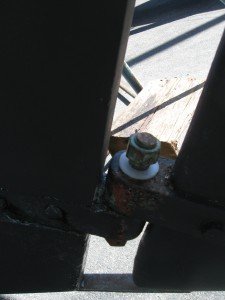
The next item was the lower rudder gudgeon, which had been slowly wearing away at the bronze hinge pin, and by now was clanking most horribly every time there was light chop in the anchorage or a passing wake made the rudder move. I had prepared some UHMD bushings, and now used the shop’s heavy-duty right-angle Milwaukee drill to ream the pintle and gudgeon holes from ¾ to 1 1/8th. It was heavier work than I had suspected, and after bending the shaft of the bit and nearly burning out the drillmotor, I decided to do just the lower one and keep the rest of the bushings as spares.

The other ones, after all, aren’t as loose as the bottom ones were. I also took the time to drill and tap a few holes into the underside of the keel for the attachment of a piece of bronze bar to act as a lobster-trap line deflector. Several times Ganymede has snagged pot warp between her keel and rudder, and it’s usually awkward to get it off, since most of that sort of fishing seems to go on in places where I don’t care to swim.
After all that hard work, putting on three coats of bottom paint was a breeze, as was repainting the sheer stripe and making it wider.

Still, I had to take an entire day and two extra afternoons of of work, and still wouldn’t have got done if Casey hadn’t preferred to launch us on Monday rather than Saturday,as we’d planned. Saturday was spent instead cleaning, compounding and waxing the hull (most of it), and putting on Ganymede’s new lettering. The original was pretty chipped and beat up, and we’d wanted bigger letters for some time, since folks complained that the name on the side was hard to read. We’ll, they’ll be able to read this.

So now Ganymede is ready to launch again, and since the engine parts haven’t come in yet, we may have to make the return to the marina strictly in forward gear. It’ll be just like old times—the bits of them it never occurred to me to miss.
Cruising Provisions and Preparatory Projects
I’d like to say that we’ve accomplished much in the week and a half since Ganymede relaunched and we returned to the marina—and we have, a truly heroic amount, really—but in light of everything we still need to do it seems less than it is. Our return was uneventful, except that the crucial engine shifter part hadn’t yet arrived, so I had to Ghetto shift by leaving the engine cowling off and reaching into it’s vital parts with an awl to get it from one gear to another. A little further to reach and harder to find than the normal shift lever, so I had to look sharp as we barreled around the corner toward our usual side-tie. I say barreled, because when freshly scraped, Ganymede is uncommon slippery, and taking the engine out of gear does little to slow her down. Fortunately our good neighbor Natalie was standing by to catch a line, and it only took a moment to heave one across the narrowing gap, locate my trusty awl, and fumble the engine into hard reverse. Natalie, who has grown up on boats and seen almost everything, recovered surprisingly quickly from thinking we were going to destroy both her and the pier and got the spring line made fast, though we didn’t need it after all as Ganymede came to a juddering halt and I scrambled to put the motor into neutral before she could start making sternway.
Now, finally, all the work we’d had to put off until “after the boatyard” could begin; most importantly, the lifeline stanchions and bulwarks. During the winter I’d unshipped the old douglas fir ones, and made new stanchions out of Black Locust, a yellowish hardwood endemic to these parts. I hadn’t been able to install them yet, as I wanted to paint the sheer stripe at the boatyard before putting all sorts of bolts on. They went on beautifully, and so did the new bulwarks I made out of African Mahogany. I’d gotten a bargain on a few pieces from a fellow I did some rigging for, and the local lumber store supplied the rest. It’s mill-finish 1X4, meant for decking, but perfect for this as well.
While I was happily engaged with screws and glue and all things manly, Danielle caught a ride with Natalie to BJ’s, a sort of Costco/Sam’s Club volume discount place. I had expected her to return loaded, sure, but even I was amazed at how much she managed to buy. Three giant dock cart loads of unperishable food and dry goods were soon piled in the cockpit, on the pier, and on the decks. The next day, Saturday, was spent from breakfast to after dark stowing all those goodies, as well as our 120 gallons of water, in the big locker under the bed and the under-settee cupboards. We had so many cruising provisions that we had no room to cook or eat, so we munched handfuls of this and that all day as hunger came and went, but mostly came. It seems a miracle, but most of the stuff is stowed, thanks partly to our neighbor’s vacuum sealer which can turn nice fat rolls of paper towels and toilet paper into tiny planks for storage.
I’ve been tempted to take a day off work to get my projects done, but this being our last week or so to make money, prefer to try and squeeze it all in after hours. So the bulwark is almost done, and then the engine can be looked at, and half-a-dozen little inside projects that require electricity will follow, and if I can get those finished before we have to move out of the marina and have no more electricity, I’ll be content to finish the last bits of rigging and stowing at anchor.
Ready or not?
“Ready to go yet?” I heard the question over and over today. Fair enough—we’ve been ‘getting ready to cruise’ ever since leaving the boatyard several blog posts ago, and have Tuesday as our target sailing date. And in a sense, we are ready, since there’s nothing big left that HAS to be done before we can cast off the docklines and unplug the extension cord. But with the neverending list of projects scrolling through my mind, a list that will still be unfinished months from now, however much we’ve cruised, it always made me pause and think. At first I’d answer, “Not quite: I still need to paint the lazarette lid, ream these belaying pin holes, sort out the storm try’sl sheets, stow the dinghy, and—well, you know. Tons of stuff.” By the end of the day, though, I had caught the true meaning of the question, and could answer, “All set. I’m just tidying up a few details until it’s time to go.” And details, really, is all that’s left.

On Friday after work I did the last big thing, sanding the new bulwarks and applying a coat of boiled linseed oil. I had intended to do some painting in the aft part of the cockpit after scrubbing the decks, but spent the day organizing the cockpit lockers, finding all my sail ties and reefing lines, stowing the foc’s’le, and adjusting the Sailomat self-steering vane so that the servo turns the same distance to either side of centerline. There are three different adjustments to that bit of it, plus adjustments to the air vane itself, in addition the attachment point of the control lines to the tiller. So it will take some sorting once we get underway, but I have high hopes.

I had wanted to leather the new sculling oar I made at work over the last couple of weeks, but didn’t have enough leather, so I wrapped the loom with gaff tape where it sits in the socket and will see if some leather comes our way by and by. Today was the first ever Marina Yard Sale, and we sold a few odds and ends of extra shackles and blocks, and spent less on other stuff than we made, so it can be deemed a success. Last of all, since the wind really piped up in the afternoon, I hoisted the new storm try’sl that Jasper and Bailey made over the winter to experiment with different sheet leads. It’s good to have these things sorted out beforehand, rather than fumbling with them in the midst of a midnight squall. A few more parrel lines to splice and she’ll be ready to go.

Another heavy-weather piece of kit we checked out was the parachute sea anchor. We’ve toted it about since we had Capella, and never used it or had it out of it’s bag. Since we’ll have it ready-rigged for quick deployment when we set off on longer passages, I wanted to see what it was all about. Pretty anticlimax, really: a big circle of cloth with webbing cords. But it’s in fine condition, so we can feel good about using it in ugly weather.
Tomorrow is set aside for rest, and Monday we’ll top up on water and food, get the sail covers off and halyards properly rove, and hope the forecast for Tuesday improves enough that our grand departure from the marina can be longer than just the 300 yards to the anchorage.
Passage to Provincetown
When I am in my ship, I see
The other ships go sailing by.
A sailor leans and calls to me
As his ship goes sailing by.
Across the sea he leans to me,
Above the winds I hear him cry:
“Is this the way to Round-the-World?”
He calls as he goes by.
A. A. Milne

It could have been the way to “Round-the-World”, or the way to Topeka, for all we could see in the thick fog as we cast off Ganymede’s dock lines and gently sculled out of the marina to avoid waking the neighbors with the sound of the engine. All that could be seen as we motored out of Narragansett Bay and past Castle Hill was the occasional dark cliff looming out of the water on the portside and a buoy or two, clanging mournfully in the swell off of Brenton Reef. The fog continued as we made sail, and prevailed until we had just passed the little island to the north of Cuttyhunk called Penikese, a half-mile to Starboard but still unseen.

The fog lifted briefly while the wind went a little more west of south, then socked in hard while Ganymede swept up Buzzard’s Bay, bringing sail in gradually until we were down to double-reefed main and stay’sl. It wasn’t cold, though, and Damaris even got a little sunburn, since the fog was not thick overhead, just side-to-side.

We debated trying to make it through the Cape Cod Canal that evening, but decided against, and good thing too, since the wind went to the North as soon as we had anchored in the lee of Piney Point, and it was no longer a lee. There wasn’t much fetch, though, and it was most pleasant to be on the hook again, and in a new place, and cruising. It’s been a whole year since we arrived in Newport, which is a terrible long time to be anywhere, even a favorite place like that. We had to wait until afternoon for a fair tide for the canal, so while the girls did very thorough lessons I sorted out some rigging odds and ends.

After lunch we sailed to the canal, only to have to anchor and wait for overhead cable work until 3:30. So it was pretty late when we finally popped out into the turbulence of the other end, and twenty miles still to go to Provincetown. Of course there’s nowhere to anchor in between, so we motorsailed at a good clip (Ganymede does splendidly close-hauled with the engine at low RPM; helps her point and goes lots faster than with just engine or sails).
New England is known for fog, and as we approached Provincetown in the dark it did not disappoint. After carefully avoiding several big fishing boats anchored with only tiny or no lights at all, we anchored in the northern bight, which made a good lee from the East wind that had brought us in. It did not make a lee at all, though, from the SW wind and seas that came up after midnight, and shortly thereafter we got up the hook at the expense of several skinned knuckles and probed slowly past the seaward side of the breakwall and into what turned out to be a group moored boats. The water being mostly flat there, we joined them and went to bed again.

In the morning the wind was blowing 25-30, and we knew why the pilgrims didn’t stay around long: there’s no shelter from it, and the long shallow area to windward lets some nasty chop develop. Still, anchor’s holding, and if we can’t lauch the dinghy and go ashore, there’s plenty of tidying to do aboard, and lessons, and books to read. It doesn’t matter really, whether we get off the boat today or not till Sunday. We’re in a new port, we had some splendid sailing, and if our cruise begins under slightly adverse conditions, we can look forward to any improvement with joy.
Sailing around Cape Sable
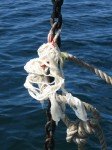
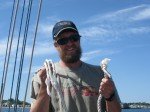
The wind finally laid down in Provincetown, though not until it had gotten really ugly, with Ganymede bucketing in three-foot breaking seas and the anchor chain pulled bar-tight. Two of the 5/8” thick nylon lines we use for anchor snubbers snapped during the blow, until finally I rigged a snubber with a triple line.
Getting ashore at last, we found our two most basic needs: grocery store and library. The library, once a Methodist church, has a half-scale model of a fishing schooner built on the second storey. The girls were disappointed that climbing the rigging was not allowed; what is rigging for, after all?

Since it was Memorial Day weekend, everything barbecue-able was on sale, and we couldn’t resist some sirloin tips, even if I had to grill them in blowing fog. It cleared up on Monday, and we gave the girls a much-longed-for run on the beach while topping up on groceries and fuel, then were off on Tuesday to cross the Gulf of Maine to Nova Scotia.

In the quiet sea with an 8-knot SE breeze, Ganymede would steer herself close-hauled with the tiller lashed, thanks to the new jib we had had made by Jasper and Bailey last summer. Though occasionally I had to reach out and alter course a little, I could leave the helm long enough to boil coffee, find a snack or navigate. It was the most pleasant of sails, and for 30 hours we didn’t need to touch a sheet or change a sail.

We were more than halfway across when the wind began to whip up, and sail had to be reduced. I had expected to have to pay the piper for our glorious day and a half of easy sailing, but the Piper’s bill was inordinate. Ganymede, by degrees, went down to stay’sl and storm try’sl, and a broad reach was all we could manage in the washboard seas. We were still making six knots, but were now headed toward the whole mess of ledges and shoals between Cape Sable and Yarmouth. It was near midnight when, about twelve miles off the nearest ledge, we hove-to, put a bright light in the cockpit, and went to bed.
Day dawned foggy and calm, but with a big swell still running. Motoring past a deep-sea lobster buoy sufficed to show where the tidal current was going, and we shaped a course for Cape Sable, hoping to get there before the flood should make. Out of the shapeless, shifting fog a Nova Scotian lobster boat would loom now and then, and one of them suddenly made a beeline for us. “Keep Guessing,” I read her name as she ranged alongside. Her skipper stuck his head out the window. “Ahoy! Where you headed?”

“The Cape.”
“You like lobstah?”
“Sure!”
His mates on the working deck had been stuffing lobsters into grocery bags as they approached, and now they ranged closer. “Lobsters on deck!” they yelled as two bulging bags of varmints flew across to land on the cabin. My thanks were drowned in the roar of the engines as Keep Guessing pulled away with a cheery wave. When we opened the bags later we found nearly eighteen of them, which gave the girls endless entertainment. Welcome to Canada!
It soon became evident that we wouldn’t make it to Cape Sable, so we groped our way, by dint of GPS and the Nova Scotia guidebook that our neighbor Mike Grimes had photocopied for us, into the quiet and lonely Stoddard Cove. It was heavenly, after the roughness of the last 24 hours, to be on an even keel. Spreading everything wet in the cockpit to dry, we set to boiling lobster and tidying up. That night we cleared the wood stove, shipped the stack, and had a fire to dry out the cabin, which was positively clammy after all the rain and fog of our crossing.
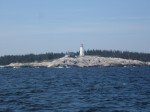
There was no fog the next day, and we took advantage of the visibility to get around Cape Sable. There was still a big swell running, and it made for some truly horrible tide rips and overfalls which bounced Ganymede around in their grip like a pea in a rattle and delayed the children’s breakfast. Once around the dreaded Cape things improved and we shaped a course for Cape Roseway, at the entrance to Shelburne harbour. Though it had started out calm, by the time we got there, there was more than a thimblefull of West wind, and fetching the lee of McNutts island we put in two reefs for the long beat up to town.
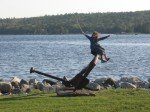
It was more wind than I care to sail upwind in, but Danielle had a wonderful time putting the rail under, tack after tack, and we managed to sail into the anchorage without breaking anything. It was too late to do anything in Shelburne other than call customs from a payphone to check in (easiest check-in to any country, ever!), and reconnoiter the town a little. It looks a splendid place, with showers at the yacht club (we last showered in Newport!) and laundry up a block. We’ll spend the weekend here, as it’s a perfect quiet harbor with no traffic, and be able to finish tidying up the boat before heading east to Lunenburg.
From Shelburne, NS to the Caribbean?
Shelburne, NS is a good harbor, in spite of a local Katabatic-sort of wind effect, where every afternoon we were there the wind came on to blow with scandalous force, till the surface seethed with whitecaps and blowing streaks of foam, especially in the lower harbor where the fetch is longer. Still, the holding was good in very sticky mud, and Ganymede was in a narrower place, and as long as the tide and wind were not in opposition, we could row back and forth, even if it involved pulling to the windward shore first and then getting along upwind.

There is a very good grocery store in town, though we didn’t need much yet in the way of supplies, and the gas station had Ethanol-free gasoline! The gas station was a long-ish walk when my two 5-gallon jugs were empty. When they were full, it was impossible. I hadn’t gone halfway back though, setting the jugs down every hundred feet or so to rest, when a police car pulled over and offered me a ride. Hooray for the Royal Canadian Mounted Police! So my jugs and I got a free ride in a cop car, and I wasn’t in handcuffs!

We had meant to leave early on Tuesday, but were delayed by a frontal passage that dumped rain torrents worthy of a tropical squall. Instead, we gave things time to clear up and in the afternoon rode the daily Katabatic, under stay’sl alone, to a mostly quiet lee nearer the harbor entrance. The next day was perfectly clear and we enjoyed that greatest of luxuries: a gentle offshore breeze, strong enough to make five knots by, but gentle enough not to make Ganymede heel in any uncivilized fashion. It was strange, though, to be out in such brilliant sunshine, with the water sparkling and mirages turning distant islands upside-down and still be icy cold. A sweater, jacket, and Nova Scotia sunhat were still not enough to keep me warm, and I mostly steered with my knees so my hands could stay hidden in pockets.

If it hadn’t been for the cold, I might have thought we were in tropical waters as Ganymede wound her way up a poorly-marked channel between submerged rocks. The water was perfectly see-through; the beaches were blinding white sand. We would probably have turned back and gone the long way ‘round into Mouton Bay if the water had been murky. Instead, though I’m really too old to do that any more, I shinnied up the mast to pilot through from the spreaders.

The water in the anchorage was not only too cold for a longed-for swim, it was awfully dark due to a stream that tumbled in across the beach. Unlike Shelburne, which was warmed up by the Roseway River that also turned the water a deep , clear yellow-black (as though Ganymede were floating in Pepsi), Mouton Bay enjoyed no heat from it’s stream, though this stream was a rich transparent vermilion, and looked like a flood of Cabernet flowing across the beige sand. I’d like to know what vegetable matter tints it so: it’s the most unique streamlet I’ve ever seen.
It was flat calm the next day. We motored out expecting the predicted West wind to fill in, and it never did, so we arrived at Lunenburg early in the afternoon after hours of motoring over an uncannily calm sea. Still, nothing like burning off that nasty Ethanol-laced American gasoline so I can replace it with clean stuff. We only had time for a quick run ashore, but it looks a lovely place.

Boats everywhere, whether huge government buoy tenders, ancient steel fishing trawlers, wooden schooners, and even several tramp steamers being dismantled for scrap. We’ll stay here for a couple of days to top up on water, fuel, and propane, get some laundry done and work on some boat projects before heading further east across Mahone Bay.
Lunenburg Hospitality

Lunenburg proved everything we could wish in the way of amenities. Two grocery stores, a big hardware store, laundromat, library, free public wifi, and plenty of dinghy dockage. While I went off one day in search of propane, Danielle filled water jugs at the dinghy dock and the girls played among the launching rails and cradles of the shipyard. Not one but four people stopped to ask whether we needed anything or a ride anywhere or whether we’d like to come over for a gam. One of these, a Finnish artist named Ben, invited us to his house for showers and laundry, and took me to Bridgewater, way up the La Have river, in his car to top up our empty propane bottle.
Since it was rainy when we went for our big day ashore, we took Ganymede in to a public day dock to avoid getting soaked rowing the dinghy in. Returning hours later, we found that the wind had shifted and was blowing a rollicking fetch straight into Ganymede’s transom. It was impossible to back out against that, so we waited until further in the evening to escape to the quiet of the anchorage.

It was calm on Monday, and we spent the morning shopping and filling a few last water bottles, then I left Danielle and the girls at the library while I fooled with the self-steering vane mount. Our exploratory attempt to use it, and some subsequent research on the web had revealed that though it can be mounted off-center, it has to be in line with the axis of the boat. For the thousandth time I cursed the convention that makes builders round the transom of boats instead of making them square and plumb, the way nature intended, as I shimmed and jury-rigged to make the mount line up the way it needs. Once that was done and the girls back aboard we hove up the anchor and made for Mahone Bay.
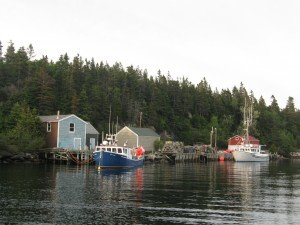
Even though it was late in the afternoon we needed to get along, so that on Tuesday we could make it to a safe haven before a nasty-looking rain system arrived. It proved a delightful day for a sail, the wind force 3 on the stern, and we gybed leisurely around one island and another as we made for New Harbor, one of the tiniest holes we’ve even anchored in, but secure and quainter than a postcard.

It’s always a treat to sail onto the anchor, and once you make it gracefully in you usually wish more people had been watching. The whole place was deserted, though I have no doubt more people watched us motor out in the calm next morning than watched us sail in the night before. We left at earliest dawn, since the bad weather was supposed to arrive at 9:00 AM, and were snugly anchored in Prospect Harbor at just that time.

The system was a little late, which gave us time to explore Pig Island by dinghy. There wasn’t much ashore but moss and rocks and rotting trees—not a single pig, to Damaris’ endless disappointment. She had meant to catch one and tame it.
When a fine drizzle began in the afternoon we built a fire in the wood stove (in June!), opened portholes to get fresh air, and scrubbed the sole and bilges thoroughly. If we neglect to do this once every week or two, the boat begins to smell musty. The heat from the fire dried everything out nicely, and we went to bed feeling fresh and dry and warm, in spite of the wind that had begun to howl outside and the rain which came pelting down in torrents. When we leave here we’ll try to get across the Halifax shipping lanes to Jeddore Harbor, the next quiet stop on our journey North and East.
Halifax to Weather

At the tail end of the weather forecast on the VHF radio, the only sort we can pick up on Ganymede when away from wifi connections, the recording said “Swell height, two meters.” Now, I don’t know how much a “meter” is, but after looking on the handy conversion chart I keep posted to the bulkhead in case a chart should be printed with “metric soundings”, it seemed impossible. Six foot swells out there? It was calmer than a millpond in Prospect Harbor, and it had been blowing offshore for days. Deciding it must be a mistake, we hauled up a very muddy anchor and sailed out through the maze of bald islands and sunken rocks that guarded the entrance to our entrancing refuge.
On coming out into open water, we found the swell forecast had been, far from an exaggeration, rather an understatement. It was good that we weren’t motoring, since without a good wind to steady the sails, Ganymede would have rolled gunnel to gunnel in the short-period, steep swell. It seems that as lows brush by the coast, the SW winds offshore generate a fearsome onshore swell, even while it’s blowing N or NE in inshore waters. It wasn’t too bad at first, sailing along close-hauled, but toward afternoon the wind came up and pointing was no longer a good option. We had gotten far enough from the shelter of the coast that the wind waves, coming against the SW swell, became really uncomfortable, and an inexplicable swell from the east seemed to be running as well, adding it’s own flavor to the confusion of the seas.

When it became evident that our intended destination would be impossible to make before dark, since it was now 25 miles straight upwind, we tacked an found we could just barely make toward Halifax—not quite, but close enough to maybe get into a lee and have quieter water to work with. Even if we could have made for Jeddore harbor, our intended stop, I hadn’t been relishing trying to enter a narrow river mouth with that kind of onshore swell breaking against the shallow bits. Far better, even if it meant getting behind schedule, to make for a deep, well-marked harbor, one which could be entered in any conditions.

We made it to Halifax well before dark, in the end, with the help of our powerful 8-hp outboard, and found it a stop worthwhile. At the very end of the Northwest Arm is a splendid anchorage suitable for all weathers; a free dinghy dock at the park; and an easy walk to shopping of every sort. We even ate out while there, something we hadn’t done since January. We arrived on Thursday night, and didn’t leave until Tuesday morning—an unprecedented stay for us who like to keep on the move.
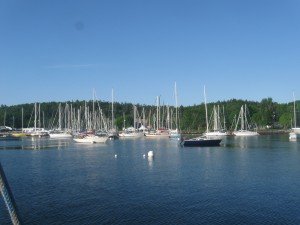
Though the swell was not much less, the wind was not opposed to it, so things got along more comfortably, in spite of the thick fog that settled in as soon as we were well underway. This fog was to be our last one for Nova Scotia, though we didn’t know it that day—all we knew was that as the wind increased toward afternoon it only got thicker and thicker. By the time we made our turn at Nichol Island to get into the Ship Harbor approach, you could have scooped it with a spatula. The turn put the wind abeam rather than astern, which always makes it seem to be blowing twice as hard, and I had the added joy of piloting in blind with a photocopy of a chart so old it didn’t have a lat/long grid. Instead I had to plot GPS positions on a larger-area chart with far less detail, then transfer them as best I could to my harbor chart. This was seafaring at it’s finest—rising wind, pea-soup fog, some horror called “Bear Rock” under our lee, and closing fast with a rock-bound shore using a chart drawn before the war of 1812. Suddenly, like I’ve been told it’s famous for doing, the fog ended right near the shore, and everything ahead could be seen as plain as could be.
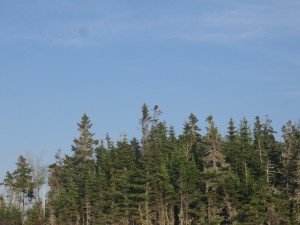
In a little while Ganymede, sails stowed and on an even keel again, lay at anchor in a tiny rock-bound bay in Passage Island. The wind whistled overhead but we were safe and snug, eating an early supper and watching a huge bald eagle sitting over it’s nest on a tall pine tree bear the shore.